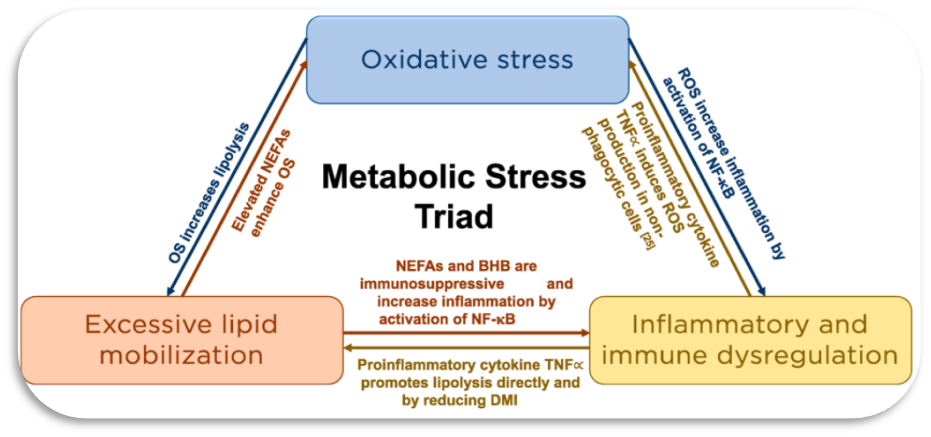Blog | Reading Time 4 minutes
A holistic approach to mitigate dairy cow transition challenges
The transition period presents the cow with several physiological, metabolic, and environmental changes. These changes often lead to immune imbalance or dysregulation and inflammation, oxidative stress, and excessive lipid mobilization: these three problems form what is described as the ‘Metabolic Stress Triad’ from which most transition cow disorders emanate.
The existence of several challenges during the transition period is evidence of the need for a holistic management approach. Although dairy cow transition challenges might sound inevitable, an effective management approach goes a long way in mitigating the problems.
A well-managed transition period reinforces rumen preparation, optimises early lactation, and enhances cow performance while ensuring calf robustness and digestive development. On the other hand, managing the transition period effectively aims to achieve the following:
- To optimize milk production,
- To ensure producers’ profitability,
- To enhance cow health while improving longevity and welfare,
- To reduce environmental impact,
- To offer consumers safe, high-quality dairy products.
The Metabolic Stress Triad
During the transition period, increased metabolic demand from the cow, along with the demands of the developing calf, can lead to oxidative stress (OS) resulting from elevated production of reactive oxygen species (ROS) as by-products of metabolism. Metabolic stress is characterized by excessive lipid mobilization, immune dysregulation and inflammation, and oxidative stress. These three processes are intrinsically linked (Figure 1) and are associated with an increased risk of metabolic and infectious disease during the transition period. The elevated adipose tissue-released non-esterified fatty acids (NEFA) and beta-hydroxybutyrate (BHB) concentrations from excessive lipid mobilization, and hypoglycaemia, as glucose is required for immune cell function, are important contributors to the periparturient immune dysregulation (Figure 1). Excessive lipid mobilization can lead to an increased risk of ketosis.
Figure 1: Schematic representation of the intrinsic relationships among the components of the metabolic stress triad.( Abuelo et al., 2019)
The cost of inflammation during the transition period
Transition cows often experience inflammation around calving due to several factors including environmental and management, metabolic demands and physiological changes. These factors lead to local inflammation in the uterus, mammary gland and digestive system, whereby lipopolysaccharides (LPS) are released in the whole body, causing systemic inflammation.
In the uterus, bacterial contamination and injuries during calving often lead to inflammation. The mammary gland is highly susceptible to bacterial infections (causing systemic inflammation), with intramammary infections most common during early involution (dry-off) and colostrogenesis. On the other end, the cow ruminant digestive system experiences stress due to dietary changes that can affect gut anatomy and physiology, and compromise gut integrity, leading to leaky gut and systemic inflammation.
Transition through diet changes and the accompanying stresses can modify the rumen microbes, switching to a more “acidotic” microbiota composition. A shift to higher-energy diets during the transition period disturbs the gut microbiome balance. This switch affects rumen fermentation and can lead to a higher risk for subacute ruminal acidosis (SARA) that will damage the rumen wall epithelium, creating a leaky gut. A leaky gut allows LPS passage, meaning that rumen and intestinal integrity may lead to inflammation through LPS passage.
During immune activation and inflammation, nutrients and energy are diverted from productive purposes to support the immune system, leading to economic consequences such as decreased growth, inefficient feed utilization, poor reproduction, and treatment costs. Controlling and maintaining inflammation and immune response during the transition period would help mitigate negative consequences on cow productivity.
Supplementing probiotic live yeast (LEVUCELL SC) improves rumen wall integrity, limits rumen epithelium inflammation and improves post-calving dry matter intake and milk production. Similarly, forage inoculants (MAGNIVA) help to improve forage value and intake.
Improving the antioxidant status of the transition cow
Oxidative stress is common in peripartum cows due to the increased metabolic activity associated with late pregnancy, parturition, and the onset of lactation. Oxidative stress is usually observed when there is an imbalance between the production of reactive oxygen species (ROS) and the body’s ability to detoxify or repair the resulting damage. Melofeed, a rich source of the antioxidant enzyme, superoxide dismutase, has been found to help maintain the antioxidant status of animals and help protect against oxidative stress.
The traditional focus has emphasised the production of metabolites such as ketones and the development of hypocalcaemia as causal to transition cow problems. However, recent research takes holistic transition management focusing on inflammation as a cornerstone of transition disorders.
Want to know more about the holistic approach to mitigate dairy cow transition challenges?
Download nowPublished Jan 16, 2025 | Updated Jan 17, 2025
Related articles
Need specific information?
Talk to an expert